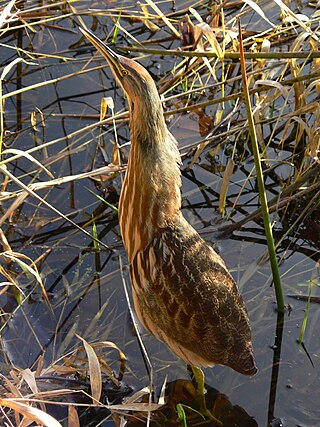
The American bittern is a species of wading bird in the heron family. It has a Nearctic distribution, breeding in Canada and the northern and central parts of the United States, and wintering in the U.S. Gulf Coast states, all of Florida into the Everglades, the Caribbean islands and parts of Central America.
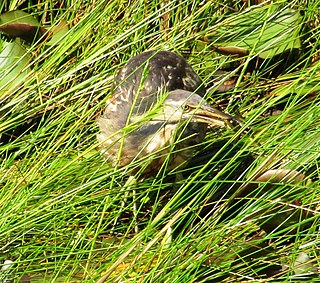
Bitterns are birds belonging to the subfamily Botaurinae of the heron family Ardeidae. Bitterns tend to be shorter-necked and more secretive than other members of the family. They were called hæferblæte and various iterations of raredumla in Old English; the word "bittern" came to English from Old French butor, itself from Gallo-Roman butitaurus, a compound of Latin būtiō (buzzard) and taurus (bull).

Herons are long-legged, long-necked, freshwater and coastal birds in the family Ardeidae, with 74 recognised species, some of which are referred to as egrets or bitterns rather than herons. Members of the genus Botaurus are referred to as bitterns, and, together with the zigzag heron, or zigzag bittern, in the monotypic genus Zebrilus, form a monophyletic group within the Ardeidae. Egrets do not form a biologically distinct group from herons, and tend to be named differently because they are mainly white or have decorative plumes in breeding plumage. Herons, by evolutionary adaptation, have long beaks.
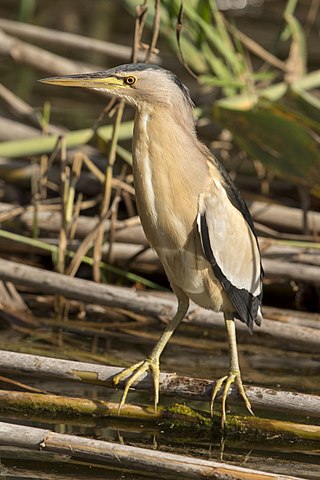
The little bittern is a wading bird in the heron family, Ardeidae. This species was formerly placed in the genus Ixobrychus.

The cinnamon bittern or chestnut bittern is a small Old World bittern, breeding in tropical and subtropical Asia from India east to China and Indonesia. It is mainly resident, but some northern birds migrate short distances. This species was formerly placed in the genus Ixobrychus.

The yellow bittern is a small bittern. It is of Old World origins, breeding in the northern Indian Subcontinent, east to the Russian Far East, Japan and Indonesia. It is mainly resident, but some northern birds migrate short distances. It has been recorded as a vagrant in Alaska and there is a single sighting in Great Britain, from Radipole Lake, Dorset on November 23, 1962 – however, the British Ornithologists' Union has always considered this occurrence to be of uncertain provenance and currently it is not accepted onto the official British List. This species was formerly placed in the genus Ixobrychus.

The black bittern is a bittern of Old World origin, breeding in tropical Asia from Pakistan, India, Bangladesh and Sri Lanka east to China, Indonesia, and Australia. It is mainly resident, but some northern birds migrate short distances. This species was formerly placed in the genus Ixobrychus.

Peter Leopold von Schrenck was a Russian zoologist, geographer and ethnographer.

Botaurus is a genus of bitterns, a group of wading birds in the heron family Ardeidae. The genus includes species that were previously placed in the genus Ixobrychus.

The least bittern is a small heron, the smallest member of the family Ardeidae found in the Americas. This species was formerly placed in the genus Ixobrychus.
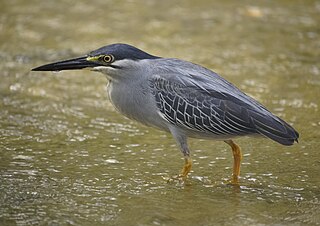
Butorides is a genus of small herons. It contains three similar species, the striated heron Butorides striatus, the lava heron Butorides sundevalli, and the green heron Butorides virescens. They are closely related, and some authorities have considered them all to be subspecies of just one species; when treated so, the merged species is called green-backed heron. The name Butorides derives from Middle English Butor ("bittern") and the Ancient Greek suffix -oides, "resembling".

The terrestrial fauna of the Cocos (Keeling) Islands is unsurprisingly depauperate, because of the small land area of the islands, their lack of diverse habitats, and their isolation from large land-masses. However, the fauna dependent on marine resources is much richer.

The pinnated bittern, also known as the South American bittern, is a large member of the heron family (Ardeidae) found in the New World tropics. Like the other Botaurus bitterns, its plumage is mostly buffy-brown and cryptically patterned. Though it is a widespread species, it is rarely seen – presumably due to its skulking habits – and much about its life history remains little known.

The white-backed night heron is a species of medium-sized heron in the family Ardeidae, found in sub-Saharan Africa.

The stripe-backed bittern is a South American bird species belonging to the family Ardeidae, which includes Herons, Egrets and Bitterns. It was formerly placed in the genus Ixobrychus. Commonly found near freshwater swamps, marshes, lake shores and streams, stripe-backed bitterns span over a wide distribution that divides into the northern and southern populations, spanning on both sides of the Andes. Although increasingly recognized and researched worldwide, much life history details are lacking concerning this species, which remains understudied compared to its similar looking sister clade, including the least bittern.

The New Zealand bittern is an extinct and enigmatic species of heron in the family Ardeidae. It was endemic to New Zealand and was last recorded alive in the 1890s.

The dwarf bittern is a species of heron in the family Ardeidae that is widely distributed across Sub-Saharan Africa avoiding only the very arid regions. This species was formerly placed in the genus Ixobrychus.
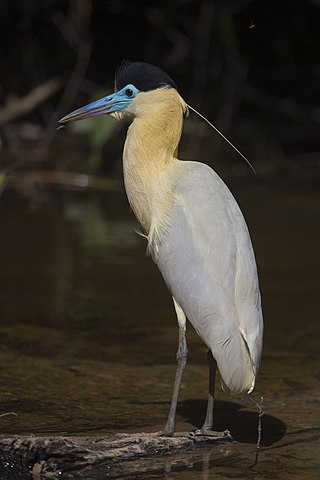
The capped heron is a water bird endemic to the neotropics, inhabiting rainforest from the center of Panama to the south of Brazil. It is the only species of the genus Pilherodius, and one of the least known of the heron family, Ardeidae. It is superficially similar to the group of the night herons, but is active during daytime or at twilight.

The white-crested tiger heron, also known as the white-crested bittern, is a species of heron in the monotypic genus Tigriornis and a member of the family Ardeidae. It is widely distributed across the African tropical rainforest, often occurring near small streams and marshes. This heron exhibits unobtrusive black, brown and buff coloration and possesses a white crest, which may be viewed when erected. Not much is known about this heron or its behaviors, although it is known to feed on the small fish, crustaceans, frogs, snakes and insects which inhabit rivers or river shores. Despite its elusiveness, it is found over a broad range and has been assessed by the International Union for Conservation of Nature as "Least Concern". Due to threats such as habitat destruction and poaching for use in medicine, its population has been decreasing over time.





















